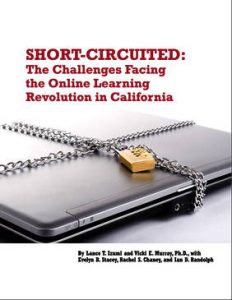Government red tape and inertia, plus union opposition, have prevented widespread student access to K-12 online learning according to the new book Short-Circuited
San Francisco—Government red tape and inertia, plus union opposition, have prevented widespread student access to K-12 online learning according to the new book Short-Circuited: The Challenges Facing the Online Learning Revolution in California, released by the Pacific Research Institute (PRI), a California-based free-market think tank. Short-Circuited, written by Lance Izumi, J.D., Koret Senior Fellow and PRI senior director of Education Studies, and Vicki Murray, Ph.D., PRI associate director of Education Studies, explores California’s education technology landscape and the impediments to its expansion.

“Of all the states, one would expect that the impact of technology on the delivery of education services would be greatest in California, home to Silicon Valley, Facebook, EBay, and other tech companies – but that’s not the case,” said Mr. Izumi. “In his campaign agenda for education, California’s new governor Jerry Brown criticized state education ’regulation run amok.’ As our book points out, this noose of red tape is especially evident in the often irrational regulations that burden online learning and virtual charter schools.”
Izumi also observed, “In addition to misguided government regulation, teacher unions in California have advocated contract language that would prevent the efficient and widespread use of online learning technologies. These contract provisions seek to protect union members at the expense of students and the cost-effective use of scarce tax dollars.”
“The adaptive nature of online learning allows instruction to address the individual needs of students,” said Dr. Murray, “Students like Mark McLean, an autistic sixth-grader living in Santa Cruz County tested at the basic or below basic levels while in public school. Now an online student at a virtual charter school, Mark is testing proficient to advanced. Like the McLeans, students and their parents should be able to decide what educational experience works best for them.”
In order to remove obstacles to online learning, Short-Circuited recommends that policy makers:
- Reform the contiguous counties rule which stipulates that students can attend only those virtual charter schools [linked to “How Virtual Charter Schools Work] located in the counties in which the students reside or in a contiguous county.
- Eliminate the 25:1 student-to-teacher ratio for virtual charter schools—a measure based on no convincing empirical evidence that it raises student achievement—and take virtual charters out of the category of independent study.
- Allow multiple authorizers [linked to explanation] for charter schools to help increase the supply of these schools.
- Lift the cap on charter school expansion, now set at 100 schools per year.
- Allow full teacher licensure reciprocity, which would allow star teachers in other states to teach in students in through online learning and virtual schools.
- Attach funding to each child so that they can take it to the school of their choice.
“If adopted these reforms could help expand the availability of online education alternatives and increase the number of students taking advantage of them, potentially improving student achievement and reducing costs at a time when the state budget is chronically in the red,” concluded Mr. Izumi.
“It’s time that California meet the demand of its students and provide them with opportunities to engage the technology which dominates the industries they are likely to enter upon graduation.”
